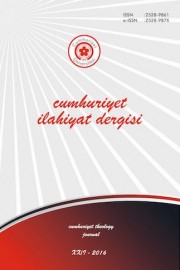Demir, Abdullah. “Ebû İshâk Zâhid es-Saffâr’ın Kelâm Yöntemi”. Doktora tezi, Cumhuriyet Üniversitesi Sosyal Bilimler Enstitüsü, Sivas 2014
Demir, Abdullah. “The Kalām Method of Abū Isḥāq al-Zāhid al-Ṣaffār”. PhD. Dissertation, Cumhuriyet University Graduate School of Social Sciences, Sivas/Turkey 2014
Author(s): Abdullah DemirSubject(s): Theology and Religion, Islam studies, Comparative Studies of Religion, Religion and science , Book-Review
Published by: Cumhuriyet Üniversitesi İlahyat Fakültesi
Keywords: Māturidism; Abū Isḥāq Ibrāhīm b. Ismāʿīl Zāhid al-Ṣaffār al-Bukhārī; Talkhīṣ al-adilla li-qawaʿid al-tawḥīd; Method of the Kalām; Defense of the Kalām; Theory of knowledge; Aql and Naql
Summary/Abstract: Abū Isḥāq Ibrāhīm al-Zāhid al-Ṣaffār is one of the important representatives of the Kalām thought of the Ḥanafī-Māturīdī School. He was born in A.H. 450/ C.E. 1058 in Bukhara that is one of the city of Transoxiana/Mawara al-nahr where Maturidi School has been emerged around this socio-cultural environment. He completed his education and served as a leader (rais/ ṣadr) of the Hanafite scholars there until he was exiled to the city of Marv. Upon his return from exile, he passed away in Bukhara in A.H. 534/ C.E. 1139. The present study aims to determine his method in Kalām. The introduction outlines the subject, significance, purpose, method and sources of the research. In this study, it was employed a method that focuses on a person in which he/she is examined with his/her views and thoughts by taking into account his/her socio-cultural factors. By doing this, the first chapter of this study deals with the political, socio-economic and scientific situation in Transoxiana, and the activities of diverse religions, sects and philosophical schools in this region in A.H. V-VI/C.E. XI-XII. In the second chapter, it studies al-Ṣaffār’s life, scientific personality, works as well as the sources that he made references to in his works in detail. In the third chapter, the kalām method of al-Ṣaffār has been tried to be determined. For this purpose, it analyzes his extant works, Talkhīṣ al-adilla li-qawāʿid al-tawḥīd and Risālah fī al-kalām and elaborates first at his defense of the Kalām that gives a great importance to reason (ʿaql) and to intellectual debates, if necessary, in theological issues. Then it explores his theory of knowledge with his ideas on the definition, possibility, sources and types of knowledge, and the epistemological understandings he defensed or criticised. Furthermore, to determine his Kalām method, it evaluates his approach towards the value of ‘aql and naql (Qurʾān-Ḥadīth) as sources of knowledge. Since this issue is a distinctive tool for unveiling the kalām methods of different mutakallims and Muslim sects. Finally, it finds out the types of istidlāl, meaning inference of one thing from the other that he used when he argues and defends his views, and illustrates with examples.
Journal: Cumhuriyet İlahiyat Dergisi
- Issue Year: 20/2016
- Issue No: 1
- Page Range: 581-582
- Page Count: 2
- Language: Turkish

